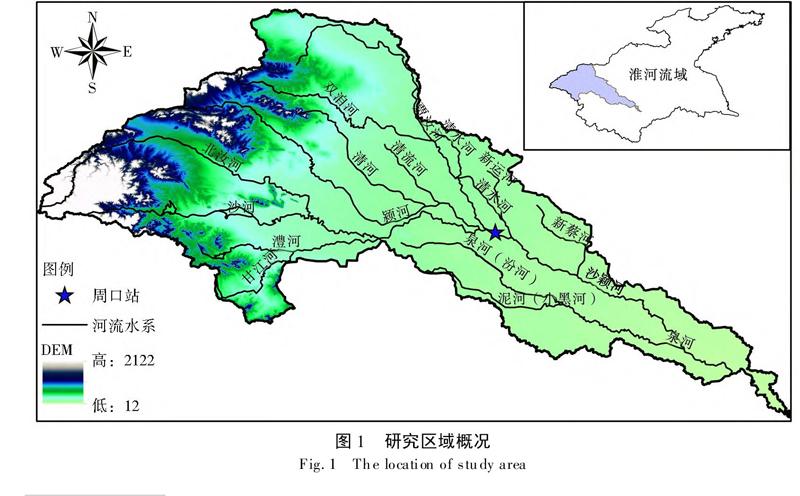确定河道内适宜生态流量的几种水文学方法
葛金金 彭文启 张汶海 渠晓东



摘要:适宜生态流量是保障河流水生态系统健康的重要变量,合理评估适宜生态流量具有现实意义。以淮河流域典型河流沙颍河为研究对象,基于沙颍河周口水文站44年天然日流量数据,运用常用的5种水文学方法计算沙颍河的适宜生态流量,通过比较5种水文学方法在计算适宜生态流量方面的优劣发现:在水量需求方面,Q50_Q90法水量需求最大,Tennant法水量需求最小,Q50_Q90法会加重“三生”用水矛盾;在水文节律模拟方面,Tessman法、月流量变动法和Lyon法较Q50_Q90法和Tennant法有明显优势;在月流量满足率方面,Tennant法和Lyon法满足率最高,其中枯水期Lyon法满足率最高。综合考虑水量需求、水文节律和满足率三方面因素,Lyon法在计算沙颍河这类季节性河流的适宜生态流量结果最为合理。
关键词:日流量数据;生态流量;水文学法;需水量;满足率
中图分类号:X143文献标志码:A
Abstract:As the amount of ecological flow is one of the important factors in maintain aquatic ecosystem,the accurate estimation of it has important practical significances.The Shaying River,a typical river in the Huai River Basin,was used in this study.In order to explore the advantages and disadvantages of five commonly used hydrological methods,the ecological flow was estimated based on the 44-year natural daily streamflow data at Zhoukou hydrological station.The results showed that the Q50_Q90 method had the largest water demand and the Tennant method had the smallest.Q50_Q90 method would increase water pressure.Meanwhile,the simulation result of natural flow regime with different hydrological methods showed that the Tessman method,the Monthly Flow variation method and the Lyon method all had obvious advantages over the Q50_Q90 method and the Tennant method.It was found that the Tennant method and the Lyon method had the highest satisfaction rates than the other method,and the Lyon method had the highest satisfaction rates in dry hydrological years than other four methods.Therefore,the Lyon method was the most reasonable method to calculate the ecological flow in seasonal river,such as Shaying River.
Key words:daily streamflow;ecological flow;hydrological method;water demand;satisfaction rate
水资源是基础性的自然资源,随着经济社会的高速发展,我国水资源开发利用率不断提高,淮河流域甚至达到53.6%[1],远远超出了国际水资源开发利用率40%的警戒线[2]。直接导致部分河流枯水期干涸断流、湿地萎缩和本地水生物种消失等一系列生态环境问题,严重制约了经济社会的可持续发展[3]。合理确定生态流量是解决这一问题的关键[4-5]。自20世纪70年代,我国开始研究生态流量以来,生态流量研究已经取得了长足的发展[6]。洪水脉冲、河流连续体等理论的提出,河湖健康指标体系的发展,促进了我国生态流量研究由维持水量到保障过程的转变[7],为维护我国的河湖生态系统健康发挥了重要作用。但是,纵观我国的生态流量研究,研究方法機理不清,方法滥用的情况仍然存在,而江河湖泊确定的生态流量又多为最小生态流量,无法满足水生态系统健康发展的内在需求。对适宜生态流量研究的忽视,严重阻碍了水生态系统修复的进程[8]。
在研究水生态系统修复过程中,河流生态学家发现,河流生态系统对水文节律的变化具有明显的响应关系,独特的水文节律特征形成了独特的水生物种群分布[9],它被称为塑造河流栖息地分布和特征的“主变量”[10]。因此,水文节律一直是研究人员合理确定生态流量的重要参考[11]。为确定生态流量,国内外学者提出了近百种计算方法,大体可以分为水文学法、水力学法、栖息地法和整体法四类[12-13],这四类方法各有优缺点。其中,水文学法是最早研究生态流量的方法,具有操作简便,数据需求量少和成本较低等优点[14-15]。在大尺度确定生态流量方面,尤其基于全球尺度分析生态流量保障问题中,水文学法更是首选方法。同时,水文学法也是四类方法中唯一基于天然水文节律确定生态流量的方法,在水文节律模拟方面较其他三类方法有明显优势。
3.3 满足率分析
将五种水文学方法计算的适宜生态流量结果与人为干扰后的实测流量状况对比,5种方法的满足率均不能达到100%。究其原因,一方面,5种方法的适宜生态流量计算结果为月均值,没有考虑天然流量的实时波动特征;另一方面,由于人类取用水,实测流量会出现低于天然流量的状况,而基于天然流量计算的适宜生态流量结果,满足率会降低。5种水文方法的满足率[HJ2.15mm]见表2,在5种方法中,Tennant法和Lyon法的满足率明显高于其他三种方法。在枯水年份,Lyon法的满足率高于Tennant法。虽然枯水年来水量少,但是在枯水年份保障适宜生态流量却更加重要。因为水生生物在枯水期对流量需求最为敏感,很多水生生物,如藻类、鱼类均在枯水期物种大量减少或死亡。因此有必要适当提高枯水期适宜生态流量的满足率[29-30]。
3.4 水文学方法比选
结合年需水量大小,水文节律模拟效果、满足率高低这三个因素,可以发现Lyon法在年需水量、水文节律和满足率方面均有极佳表现。建议在沙颍河段采用Lyon法计算适宜生态流量,虽然Tennant法的年需水量最小,满足率最高,但是在五种方法中Tennant法在水文节律模拟方面效果最差。因此不推荐在沙颍河使用Tennant法。计算表明,适宜生态流量的满足率易受到水文年的影响,丰水年满足率高,枯水年满足率低。因此,建议水资源管理单位适当放宽适宜生态流量在枯水年的评估要求,建立生态流量的枯水年、平水年和丰水年的分期考评制度。
4 结论
本文基于沙颍河长序列还原流量数据,对比分析了常用的五种计算生态流量的水文学方法优劣,得出如下結论。
(1)五种方法中,Q90_Q50需水量最大,保证率最低,同时Q90_Q50法还会出现生态流量大于个别天然月均流量的状况,加重沙颍河本地“三生”用水矛盾。因此,Q90_Q50的计算结果不适用于沙颍河这种季节性河流。
(2)在水文节律模拟方面,Tessman法、月流量变动法和Lyon法在对天然水文节律效果最好,Tennant法效果最差,年内季节性变动剧烈的河流不建议使用Tennant法。
(3)综合考虑需水量、水文节律演替、满足率三方面因素,建议在沙颍河这类季节性河流中使用Lyon法计算适宜生态流量。
参考文献(References):
[1] 赵家祥,朱梅,赵博.淮河中游枯水期水资源利用及缺水态势研究[J].治淮,2016(3):8-10.(ZHAO J X,ZHU M,ZHAO B.Study on water resources utilization and water shortage situation in the middle of the Huai River in dry season[J].Control Huai River,2016(3):8-10.(in Chinese))DOI:10.3969/j.issn.1001-9243.2016.03.004.
[2] World Bank Group.World development indicators 2014[M].World Bank Publications,2014.DOI:10.1596/978-1-4648-0163-1.
[3] 陈毅,郭纯青.北部湾经济区河流环境流量计算[J].中国农村水利水电,2012(1):8-12.(CHEN Y,GUO C Q.The calculation of environment flow of the economic region in beibu gulf[J].China Rural Water and Hydropower,2012(1):8-12.(in Chinese))DOI:10.7666/dy2095590.
[4] SHENTON W,BOND N R,JIAN D L Y,et al.Putting the “Ecology” into environmental flows:ecological dynamics and demographic modelling[J].Environmental Management,2012,50(1):1-10.DOI:10.1007/s00 267-012-9864-z.
[5] PAHL-WOSTL C,ARTHINTON A,BOGARDI J,et al.Environmental flows and water governance:managing sustainable water uses[J].Current Opinion in Environmental Sustainability,2013,5(3-4):341-351.DOI:10.1016/j.cosust.2013.06.009.
[6] 董哲仁,张晶,赵进勇.环境流理论进展述评[J].水利学报,2017,48(6):670-677.(DONG Z R,ZHANG J,ZHAO J Y.Comments upon progress of environmental flows assessments[J].Journal of Hydraulic Engineering,2017,48(6):670-677.(in Chinese))DOI:10.13243/j.cnki.slxb.20161056.
[7] 陈昂,王鹏远,吴淼,等.国外生态流量政策法规及启示[J].华北水利水电大学学报(自然科学版),2017,38(5):49-53.(CHEN A,WANG P Y,WU M,et al.Ecological flow policies and regulation review and enlightenment[J].Journal of North China University of Water Resources and Electric Power,2017,38(5):49-53.(in Chinese))DOI:10.3969/j.issn.1002 -5634.2017.05.006.
[8] 陈昂,隋欣,廖文根,等.我国河流生态基流理论研究回顾[J].中国水利水电科学研究院学报,2016,14(6):401-411.(CHEN A,SUI X,LIAO W G,et al.Review study on instream ecological base flow in China[J].Journal of China Institute of Water Resources and Hydropower Research,2016,14(6):401-411.(in Chinese))DOI:10.13244/j.cnki.jiwhr.2016.06.001.
[9] SUEN J P.Potential impacts to freshwater ecosystems caused by flow regime alteration under changing climate conditions in Taiwan[J].Hydrology and Earth System Sciences Discussions,2008,5(6):115-128.DOI:10.5194/hessd-5-3005-2008.
[10] [ZK(#]POFF L R,ALLAN J D,BAIN M B,et al.The Natural Flow Regime[J].Bioscience,1997,47(11):769-784.DOI:10.2307/1313099.
[11] YANG H C,SUEN J P,CHOU S K.Estimating the ungauged natural flow regimes for environmental flow management[J].Water Resources Management,2016,30(13):1-14.DOI:10.1007/s11269-016-1437-0.
[12] THARME R.E.A global perspective on environmental flow assessment:emerging trends in the development and application of environmental flow methodologies for rivers[J].River Research and Applications,2003,19(5-6):397-441.DOI:10.1002/rra.736.
[13] 洪思扬,王红瑞,朱中凡,等.基于栖息地指标法的生态流量研究[J].长江流域资源与环境,2018,27(1):168-175.(HONG S Y,WANG H R,ZHU Z F,et al.Research of ecologic flow based on habitat index method[J].Resources and Environment in the Yangtze Basin,2018,27(1):168-175.(in Chinese))DOI:10.11870/cjlyzyyhj201801019.
[14] KARIMI S S,ESLAMIAN S.Use of hydrological methods for assessment of environmental flow in a river reach[J].International Journal of Environmental Science & Technology,2012,9(3):549-558.DOI:0.1007/s 13762-012-0062-6.
[15] ABDI R,YASI M.Evaluation of environmental flow requirements using eco-hydrologic-hydraulic methods in perennial rivers[J].Water Science & Technology A Journal of the International Association on Water Pollution Research,2015,72(3):354-63.DOI:10.2166/wst.2015.200.
[16] CAISSIE J,CAISSIE D,JABI N.Hydrologically based environmental flow methods applied to rivers in the Maritime Provinces (Canada)[J].River Research & Applications,2015,31(6):651-662.DOI:10.1002/rra.2772.
[17] 于松延,徐宗学,武玮.基于多种水文学方法估算渭河关中段生态基流[J].北京师范大学学报(自然科学版),2013,49(z1):175-179.(YU S Y,XU Z X,WU W.Ecological baseflow in the Guanzhong reach of the Wei River estimated by using different hydrological methods[J].Journal of Beijing Normal University,2013,49(z1):175-179.(in Chinese))DOI:10.1002/hyp.7944.
[18] 左其亭,罗增良,石永强,等.沙颍河流域主要参数与自然地理特征[J].水利水電技术,2016,47(12):66-72.(ZUO Q T,LUO Z L,SHI Y Q,et al.Main parameters and physiographic characteristics of Shayinghe River Basin[J].Water Resources and Hydropower Engineering,2016,47(12):66-72.(in Chinese)) DOI:10.13928/j.cnki.wrahe.2016.12.015.
[19] TENNANT D.L.Instream flow regimens for fish,wildlife,recreation and related environmental resources[J].Fisheries,1976,1(4):6-10.DOI:10.1577/1548-8446(1976)001<0006:ifrffw>2.0.co;2.
[20] SMAKHTIN V,REVENGA C,DOLL P.A.Pilot global assessment of environmental water requirements and scarcity[J].Water International,2004,29(3):307-317.DOI:10.1080/02508060408691785.
[21] PASTOR A V,LUDWIG F,BIEMANS H,et al.Accounting for environmental flow requirements in global water assessments[J].Hydrology and Earth System Sciences,18,12(2014-12-11),2014,18(12):14987-15032.DOI:10.5194/hess-18-5041-2014.
[22] OPDYKE D R,OBORNY E L,VAUGH S K,et al.Texas environmental flow standards and the hydrology-based environmental flow regime methodology[J].Hydrological Sciences Journal,2014,59(3-4):820-830.DOI:10.1080/02626667.2014.892600.
[23] GAUPP F,HALL J,DADON S.The role of storage capacity in coping with intra- and inter-annual water variability in large river basins[J].Environmental Research Letters,2015,10(12):125001-125012.DOI:10.1088/1748-9326/10/12/125001.
[24] SHADKAM S,LUDWIG F,VLIET M T H,et al.Preserving the world second largest hypersaline lake under future irrigation and climate change[J].Science of the Total Environment,2016,559:317-325.DOI:10.1016/j.scitotenv.2016.03.190.
[25] 張锦,徐琳瑜.基于河道径流可变区间的河流水资源可开发利用率分析[J].水资源保护,2015(4):37-41.(ZHANG J,XU L Y.Analysis of exploitable rate of river water resource based on variable interval of river runoff[J].Water Resources Protection,2015(4):37-41.(in Chinese)) DOI:10.3880/ j.issn.1004 6933.2015.04.007.
[26] GE J,PENG W,HUANG W,et al.Quantitative assessment of flow regime alteration using a revised range of variability methods[J].Water,2018,10(5):597-608.DOI:10.3390/w10050597.
[27] SNELDER T H,J.BOOKER D.Nature flow regime classification are sensitive to definition procedures[J].River Research & Applications,2014,29(7):822-838.DOI:10.1002/rra.2581.
[28] WHEELER K,WENGER S J,FREEMAN M C.States and rates:Complementary approaches to developing flow-ecology relationships[J].Freshwater Biology,2017,8(14):1-11.DOI:10.1111/fwb.13001.
[29] JOWETT I G,RICHARDSON J,BONNETT M L.Relationship between flow regime and fish abundances in a gravel-bed river,New Zealand[J].Journal of Fish Biology,2010,66(5):1419-1436.DOI:10.1111/j.0022-1112.2005.00693.x.
[30] KLAAR M J,DUNBAR M J,WARREN M,et al.Developing hydroecological models to inform environmental flow standards:a case study from England[J].Wiley Interdisciplinary Reviews Water,2014,1(2):207-217.DOI:10.1002/wat2.1012.

